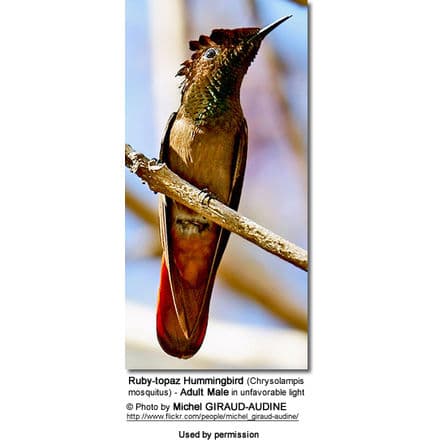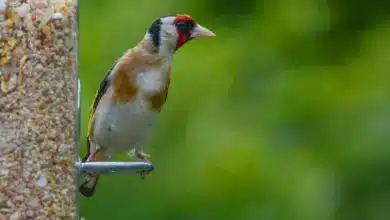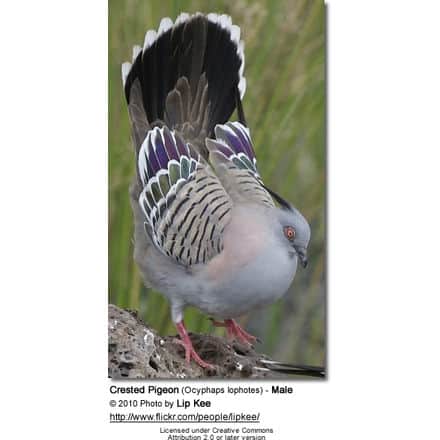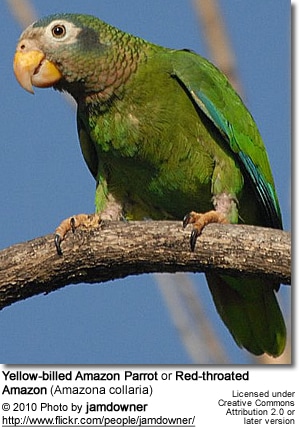Ruby-topaz Hummingbirds
The Ruby-topaz Hummingbirds (Chrysolampis mosquitus) – or simply referred to as “Ruby Topazes” — occur naturally from southern Panama (the southernmost country of Central America) south through the South American countries of Colombia, Venezuela, and the Guyanas to north-eastern and central Brazil and northern Bolivia.
They are also found on the Lesser Antilles island group and south on the islands of Trinidad and Tobago in the Caribbean Sea.
They occur from sea level to shrubby arid hillsides, up to an altitude of ~5,600 ft (1700 m), but are most common below 1,600 feet (500 m).
These aggressive birds are commonly seen in gardens, cultivated areas, open country, and along the forest edge, where they forage from low down to treetops.
They appear to be sedentary within parts of their range and seasonally migratory in others.
In Brazil, they perform north-south migrations; traveling along the coastal regions of the Guyanas, Venezuela, and Colombia, where they are likely doing an east-west migration, moving southwards to Colombia where they arrive in May and leave again in September.
Some migratory movements are also suspected to occur on the islands of Trinidad and Tobago. However, their movements are still poorly understood.
Alternate (Global) Names
Portuguese: Beija-flor-vermelho; Spanish: Colibrí Rubí; Italian: Colibrì rubino-topazio; French: Colibri rubis-topaze; German: Moskitokolibri; Dutch: Rode Kolibrie
Description:
The Ruby Topaz Hummingbirds measure between 3.1 – 3.5 inches (~8 – 9 cm) in length (including the tail) and weigh between 0.1 – 0.2 oz (3.5 – 5 g).
The black bill is short and straight; the eyes are dark brown, and the legs and feet are blackish.
This hummingbird shows great variances as far as the color of plumage is concerned. In poor light conditions, the plumage appears dull blackish-brown. In the right light conditions, the brilliant iridescence of its plumage can be seen.
The adult male has an iridescent green dark/brown upper plumage with a brilliant ruby red to orangey crown (top of the head) and nape (back of the neck) and a shiny golden to emerald-green throat and chest (depending on light conditions). In poor light conditions, the male often looks dark. His underplumage is brown. His chestnut-colored tail is tipped black. The wings are dark grey.
While perched, the males often spread their tails and ruffle their crown feathers in a display.
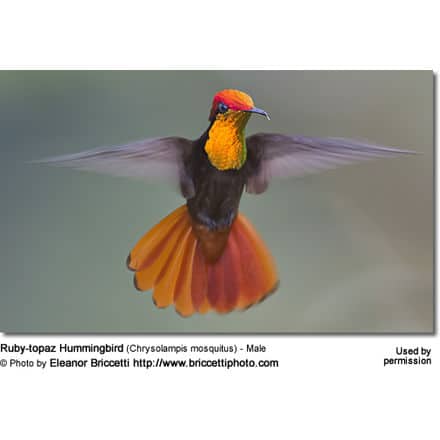

The adult female Ruby-topaz Hummingbirds (depicted above) has a mostly bronze-green upper plumage and is pale grey below. She has a dark chin stripe. Her tail is chestnut-colored with white tips.


Juveniles look like adult females. Immature males have a white spot behind the eye and the outer tail feathers are violet with white tips.
Regional Differences: Specimens from Trinidad and Tobago occasionally have a greenish-orangey stripe from the chin, down to the chest.
Call / Vocalization:
The Ruby-topaz Hummingbirds call is described as very short, high-pitched tsii tsii tsii. They also utter chirps and whistles, and a series of rapid chattering.
Nesting / Breeding
The breeding season of the Ruby Topaz Hummingbirds differs according to the range they are found in. On the islands of Trinidad and Tobago, it starts in December and goes on until June. In Brazil, they breed from September through January.
Hummingbirds in general are solitary and neither live nor migrate in flocks; and there is no pair bond for this species – the male’s only involvement in the reproductive process is the actual mating with the female.
The male Ruby Topaz performs a courtship display to attract females. He quickly circles the female, flashing his bright colors by fanning widely the chestnut tail and raising the ruby-red crown feathers.
He will separate from the female immediately after copulation. One male may mate with several females. In all likelihood, the female will also mate with several males. The males do not participate in choosing the nest location, building the nest, or raising the chicks.
The female is responsible for building the cup-shaped nest out of plant fibers woven together and green moss on the outside for camouflage in a protected location in a shrub, bush, or tree – usually in the fork of a small branch about 3 – 13 feet (1 – 4 m) above the ground.
She lines the nest with soft plant fibers, animal hair, and feathers down, and strengthens the structure with spider webbing and other sticky material, giving it an elastic quality to allow it to stretch to double its size as the chicks grow and need more room. The outside is decorated with lichens and pieces of bark, which present a perfect camouflage for the nest.
The average clutch consists of 1 to 3 white eggs, which she incubates alone for about 15 – 16 days, while the male defends his territory and the flowers he feeds on. The black chicks are born blind, covered in sparse brownish down on the back. The female alone protects and feeds the chicks with regurgitated food (mostly insects since nectar is an insufficient source of protein for the growing chicks). As is the case with other hummingbird species, the chicks are brooded only the first week or two and are left alone even on cooler nights after about 12 days – probably due to the small nest size. The chicks leave the nest when they are about 19 -22 days old. She usually raises one brood in a season. The young are ready to breed in their second year.
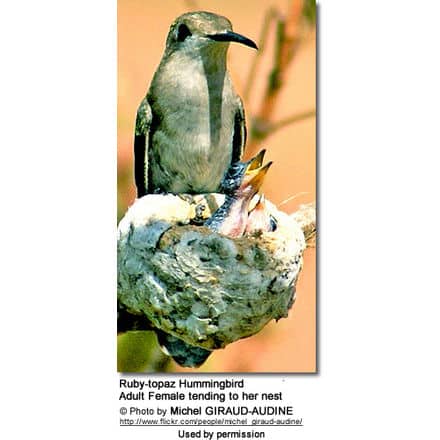
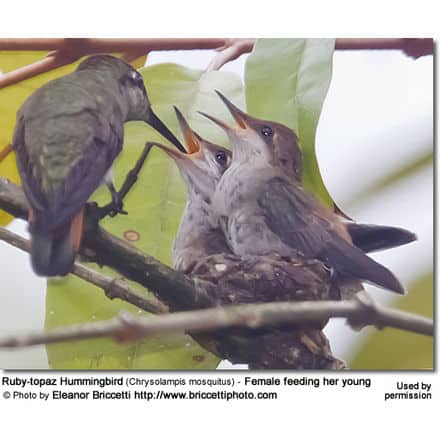
Diet / Feeding
The Ruby-Topaz Hummingbirds primarily feed on nectar taken from a variety of brightly colored, scented small flowers of trees, shrubs, epiphytes, and cacti. They favor flowers with the highest sugar content (often red-colored and tubular-shaped) and seek out, and aggressively protect, those areas containing flowers with high-energy nectar. They are particularly fond of the flowers of the Samaan tree and the ixora plant.
Hummingbird Resources
- Hummingbird Information
- Hummingbird Amazing Facts
- Attracting Hummingbirds to Your Garden
- Hummingbird Species
- Feeding Hummingbirds


